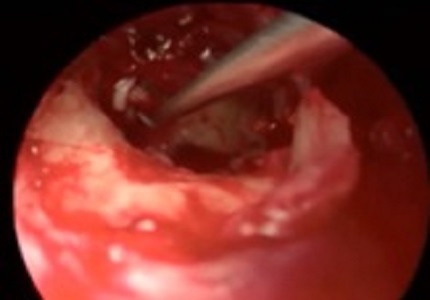Endoscopic exploratory tympanotomy findings in conductive hearing loss: a surgical review
Abstract
Background: Conductive hearing loss continue to remain undiagnosed in a large number of patients with intact membrane. Endoscope assisted tympanotomy provides an alternative technique for diagnosis and also facilitates treatment.
Methods: A prospective analysis over a 5 year period of 72 exploratory tympanotomies for conductive hearing loss was performed in patients with intact tympanic membrane. Per operative findings were treated in the same sitting. Post-operative follow up of the patient was done up to 6 months.
Results: The most common operative diagnosis was found to be otosclerosis (66%), followed by traumatic ossicular dislocation, tympanosclerotic patch, middle ear adhesions, foreign bodies etc. Small fenestra Stapedotomy with prosthesis insertion was the preferred surgical procedure performed in this study, resulting in perceptible hearing improvement post operatively.
Conclusion: Endoscope assisted tympanotomy and associated middle ear surgeries serves as an effective diagnostic and therapeutic option. This study is of value in assessing the surgical challenges in diagnosis and definitive treatment for conductive hearing loss with an intact tympanic membrane.
Downloads
References
Kim SH, Cho YS, Kim HJ, Kim HJ. Operative findings of conductive hearing loss with intact tympanic membrane and normal temporal bone computed tomography. Eur Arch Otorhinolaryngol. 2014 Jun;271(6):1409-14. doi: https://doi.org/10.1007/s00405-013-2585-y.
Harugop AS, Mudhol RS, Godhi RA. A comparative study of endoscope assisted myringoplasty and micrsoscope assisted myringoplasty. Indian J Otolaryngol Head Neck Surg. 2008 Dec;60(4):298-302. doi: https://doi.org/10.1007/s12070-008-0099-5. Epub 2008 Nov 7.
Nomura Y. Effective photography in otolaryngology-head and neck surgery: endoscopic photography of the middle ear. Otolaryngol Head Neck Surg. 1982 Jul-Aug;90(4):395-8.
Takahashi H, Honjo I, Fujita A, Kurata K. Transtympanic endoscopic findings in patients with otitis media with effusion. Arch Otolaryngol Head Neck Surg. 1990 Oct;116(10):1186-9.
Poe DS, Bottrill ID. Comparison of endoscopic and surgical explorations for perilymphatic fistulas. Am J Otol. 1994 Nov;15(6):735-8.
Kakehata S, Hozawa K, Futai K, Shinkawa H. Evaluation of attic retraction pockets by microendoscopy. Otol Neurotol. 2005 Sep;26(5):834-7.
Kakehata S, Futai K, Kuroda R, Shinkawa H. Office-based endoscopic procedure for diagnosis in conductive hearing loss cases using OtoScan Laser-Assisted Myringotomy. Laryngoscope. 2004 Jul;114(7):1285-9.
Paparella MM, Koutroupas S. Exploratory tympanotomy revisited. Laryngoscope. 1982 May;92(5):531-4.
Robertson G, Mills R. Findings at exploratory tympanotomy for conductive hearing loss. J Laryngol Otol. 2009 Oct;123(10):1087-9. doi: https://doi.org/10.1017/S0022215109005696. Epub 2009 Jul 1.
Kim SC, Lee WS, Kim M, Jeon JH, Kim J, Choi JY. Third windows as a cause of failure in hearing gain after exploratory tympanotomy. Otolaryngol Head Neck Surg. 2011 Aug;145(2):303-8. doi: https://doi.org/10.1177%2F0194599811403076.
Usami S, Iijima N, Fujita S, Takumi Y. Endoscopic-assisted myringoplasty. ORL J Otorhinolaryngol Relat Spec. 2001 Sep-Oct;63(5):287-90.
Tarabichi M. Principles of Endoscopic ear surgery. ENT and Audiology News 2012;21[3]:42-44.
Thiagarajan B , Ulaganathan V. Endoscope assisted myringoplasty. Otolaryngology online journal 2012;2(1) http://www.jorl.net



 OAI - Open Archives Initiative
OAI - Open Archives Initiative


